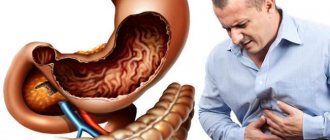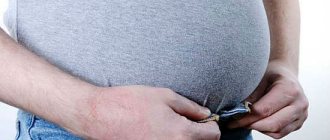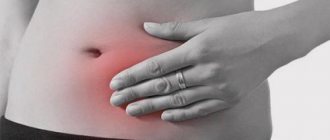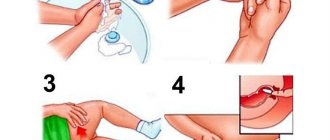- Causes of pain
- Diagnostics
- Possible diseases
- Treatment
- Our doctors
The right side of the abdomen contains several vital organs. The development of pathology in one of them provokes characteristic pain. Knowing the causes of this condition is necessary for timely consultation with a doctor and will help avoid serious complications.
Most often, women are bothered by pain in the lower abdomen. But in some cases this symptom manifests itself in men. Knowing the possible causes, you can immediately consult a doctor for help if you suspect a pathology. This will avoid complications and significantly speed up recovery.
What organs are located in a man's right side?
Pain in the lower abdomen on the right due to malfunction:
- gallbladder;
- prostate;
- liver;
- large and small intestines;
- pancreas;
- stomach;
- organs of the urinary system.
Unexpected, sharp, acute pain is possible due to injury to internal organs, which happens with appendicitis, movement of stones in the kidneys, inflammation of the peritoneum, and intestinal obstruction. In case of sluggish inflammatory processes, for example, with pyelonephritis, prostatitis, colitis, a gradual increase in pain is observed. Pulsating severe pain begins with dysfunctions that are accompanied by intracavitary pressure above normal.
Explanation: ultrasound diagnostic results and diseases in the images
| Ultrasound result | Display | Conclusion |
| Hyperechogenicity | Bright areas on the monitor | Seals: gallstones, kidney stones, cirrhosis of the liver, pancreatitis, uterine fibroids, obliteration of nodes (calcifications in nodes) |
| Hypoechogenicity | Dark patchy areas | Inflammatory process: cholecystitis, endometriosis, appendicitis, fibroids, inflammation of the appendages (salpingitis, oopharitis) |
| Anechoicity | Black spots | Free fluid: characteristic of liver cirrhosis, peritonitis, injuries of the liver and spleen, ectopic pregnancy, rupture of an ovarian cyst, ovarian apoplexy. |
If abdominal pain is accompanied by flatulence, ultrasound becomes ineffective.
If inflammation is suspected, the patient undergoes blood tests, and the level of platelets and eosinophils can be used to determine whether there is an inflammatory process in the body.
Possible causes of discomfort
The causes of pain in the right side are varied. This includes an inactive lifestyle, poor nutrition, failure to comply with personal hygiene rules, infections, and helminthic infestations. Some diseases are caused by genetics.
Diseases that cause pain in the right side of the abdomen, as a rule, do not have a specific clinic. Most of them lead to indigestion, changes in stool, and increased temperature as an inflammatory process occurs. Therefore, it is better not to start self-treatment, but to seek qualified medical help.
In addition to the pain syndrome, additional signs arise that will help a man understand which system of the body has failed and which doctor needs to be consulted. So, if pain in the abdomen is caused by liver disease, then a consultation with a hepatologist is necessary, and if it is kidney dysfunction, then you need to consult a urologist.
In case of intense, prolonged pain, you should not wait, but rather call an ambulance
Intestinal obstruction
A condition in which the movement of food through the intestines is seriously impaired or completely stopped. The disease most often occurs in older people, as well as in those who have undergone surgery on the stomach or intestines.
To confirm the diagnosis, an x-ray examination of the abdominal organs and a blood test are urgently performed. As an additional method, ultrasound examination of the abdominal organs is used.
Surgical treatment of intestinal obstruction when conservative measures are unsuccessful consists in removing the obstacle (dissection of adhesions). In this case, factors such as the prevalence of adhesions, the severity of intestinal paresis and the frequency of relapses are taken into account.
The nature and characteristics of the course of pain in the lower abdomen on the right in men
| Characteristics of pain | Possible reasons |
| Acute, sharp pain that occurs suddenly (often without previous symptoms) | Emergency, acute conditions in which rupture or damage to internal organs occurs (for example, movement of kidney stones). Also, a similar clinical picture is characteristic of intestinal obstruction, appendicitis, acute inflammation of the peritoneal tissue (peritonitis) |
| The pain starts and gets worse gradually | Sluggish inflammatory processes: prostatitis, chronic pyelonephritis, chronic intestinal colitis |
| Continuous sharp or nagging pain, spasms | Inflammation of the genitourinary system, problems with the intestines |
| Throbbing pain of high intensity | Diseases accompanied by increased intracavitary pressure in organs consisting of walls and a free cavity |
Regardless of the location of pain, its intensity, or the characteristics of its course, it is necessary to consult a doctor if such a symptom appears periodically. Some serious illnesses begin with mild to moderate pain in the lower abdomen. If you undergo examination and begin treatment at this stage, you will be able to avoid many serious complications and consequences.
Inflammation of the urinary system
Perhaps the pain in a man on the right lower abdomen is caused by dysfunction of the kidneys, bladder, urethra or ureter. The most common are pyelonephritis, cystitis, urethriatitis, and urolithiasis. If there is inflammation of the bladder, then stabbing pain appears.
Dysfunction of the urinary system is caused by insufficient hygiene, unprotected sexual intercourse, and hypothermia.
Pyelonephritis is characterized by increased body temperature, weakness, headache, severe sweating, nausea and vomiting, difficulty urinating, and cloudy urine. With urolithiasis, blood may appear in the urine, and nausea and vomiting are often observed.
If stones come out of the right kidney or ureter, then dull aching pain in the lower abdomen will be felt on the right side, then it spreads to the groin and genitals. During exacerbation, nagging pain in the side does not subside even during rest. Physical activity, vibration, and drinking a lot of liquid can provoke the release of stones.
If sharp paroxysmal pain appears in the area of the ureter, urethra, bladder, they affect the lower back and external genitalia, suprapubic, inguinal and iliac region, then most likely it is renal colic. It occurs due to the release of stones, which, due to their size, cannot freely pass along the paths and injure them.
Cystitis, in addition to aching pain in the side, is manifested by hyperthermia, nausea, vomiting, cloudy urine, frequent urination with a burning sensation, even after emptying there remains a feeling of fullness of the bladder, blood may be present in the urine. Repeated inflammation occurs due to hypothermia, hormonal shifts, decreased body defenses, and blood stagnation in the pelvic area.
Bladder cancer at the first stage hardly shows itself; over time, blood appears in the urine, urination becomes painful and too frequent, and lower back pain bothers you.
Making a diagnosis depending on the nature of the pain
| The pain is dull. |
|
| The pain is acute. |
|
| The pain occurs like contractions. |
|
| The pain is sharp. |
|
| The pain is aching. |
|
| The pain is nagging. |
|
| The pain is cutting. |
|
| The pain is very intense. |
|
Bowel diseases
Intestinal function is negatively affected by a passive lifestyle, unbalanced diet, drinking alcohol, smoking, and stress. If the intestines are disrupted, heaviness and bloating are felt in the abdomen, diarrhea begins (defecation from 3 to 20 times per day) or, conversely, constipation (the intestines do not empty for more than three days).
With intestinal dysfunction, the pain is nagging, caused by contraction of smooth muscles.
Pain in the right side in men may occur due to inflammation of the appendix, which is an appendage of the cecum and is located between the ilium and the navel. The pathology provokes acute pain, nausea, vomiting, and fever. At first the whole stomach hurts, but after two hours the pain intensifies and is felt in the right side at the very bottom.
The appendix may be located atypically, so pain in the pubic area or lower back is likely
The right side hurts severely and as a result of inflammation of the small intestine (ileitis). Pathology develops due to the activity of pathogenic microorganisms. It is characterized by pain in the side, flatulence, vomiting, nausea, and diarrhea. If the disease becomes chronic, the mucous tissue of the small intestine gradually atrophies.
In Crohn's disease, inflammation can develop in any part of the digestive tract. If the lesion affects the large intestine, then the person feels severe discomfort in the right iliac region, nausea, fever, in addition, vomiting, diarrhea occurs, and weight decreases sharply.
What pain does appendicitis cause?
Ulcerative colitis results in intense, sharp pain on the lower left or right side, depending on where the inflammation is located in the colon.
If there are painful abdominal cramps, belching, constipation, vomiting, then this is probably due to intestinal obstruction. It occurs because motor skills are impaired, as a result of which accumulated food is not evacuated. The pain increases over the course of two days and is characterized as bursting and acute.
As a result of heavy lifting or prolonged tension of the abdominal muscles, a hernia can occur, which can also cause pain in the right lower side. The hernia is most often found in the inguinal canal, where the spermatic cord is located. If its size is significant, then the protrusion can be seen when examining the groin area.
If the hernia is small, it is not visible, but it causes nagging pain in the right side of the lower abdomen (especially during physical activity, coughing or sneezing) and swelling of the scrotum. An inguinal hernia is surgically removed. When a hernia is strangulated (the clinical picture is supplemented by redness of the skin around the protrusion, fever, acute pain with burning when urinating or defecating), peritonitis may begin, which can lead to blood poisoning and death.
Pain in the area of the stomach and intestines can be caused by infectious diseases (botulism, tetanus, salmonellosis, cholera, dysentery) or helminthic infestation.
You can become infected with intestinal infections by consuming contaminated water or food if personal hygiene rules are not followed.
If the intestinal tumor is located on the right side, then it provokes moderate nagging or cramping pain in the right side of the abdomen. At first, the formation of the disease does not provoke painful sensations, but as it develops, neighboring tissues are affected. With colorectal cancer, constipation, bleeding from the anus, pain during bowel movements appear, weight loss and a constant increase in basal temperature are also observed.
Liver pathology
If the lower abdomen on the right side hurts moderately, this may indicate pathologies occurring in the liver. The organ does not have nerve endings, therefore it itself does not hurt. As a result of inflammation, the size of the liver increases, and it begins to put pressure on neighboring organs, which leads to pain in the right side.
Deterioration in function is indicated by yellowing of the sclera and skin, indigestion, low-grade fever, and changes in the color of feces and urine. If there is an abscess, then sweating increases and muscle discomfort appears.
Gallbladder dysfunction
When the functioning of the gallbladder and its ducts changes, a sharp pain is felt in the upper right part of the abdomen. As smooth muscle tone occurs, sensations migrate to the back, under the left shoulder blade, to the heart area.
Gallbladder pathologies leading to pain in the right side:
- cholecystitis (inflammation of the bladder). With pathology, digestion is disrupted because not enough bile enters the duodenum;
- cholelithiasis. The release of the stone from the bladder leads to severe paroxysmal pain. Pain appears between the right hypochondrium and the epigastrium, it migrates to the shoulder;
- Cholangitis (inflammation of the ducts) develops as a result of blockage of the ducts. The pain appears cramping and is localized in the area of the right hypochondrium or epigastrium.
If there are no stones in the bladder, then the sensations are moderate
Prostate inflammation
Pain in the right lower abdomen in an adult man is often due to prostatitis. The acute form of the pathology is rare. Prostatitis is mostly asymptomatic, with exacerbations occurring 1–2 times a year. Discomfort appears in the area above the pubis and extends to the genitals.
The intensity of pain varies from barely noticeable to unbearable depending on the degree of inflammation. It is characterized as pulling. With the disease, difficulty and frequent urination, decreased potency. If severe acute pain occurs that does not subside within an hour, you should immediately seek medical help.
Pain in the right side of a man is even moderate and occurs periodically and requires attention from a specialist. Since the clinical picture of the disease often does not have specific symptoms, and sometimes the only sign of pathology is discomfort in the right side, it is necessary to undergo a full examination to find out why the discomfort appeared.
Treatment
Therapeutic tactics depend on the specific diagnosis given to the patient. Surgery is performed for splenic infarction, appendicitis, intestinal abscess, prostate adenoma.
Irritable bowel syndrome, Crohn's disease, and prostate inflammation require correction with medications.
Oncological tumors are always removed. Depending on the type of tumor, chemotherapy or radiation therapy is prescribed, and sometimes both of these methods are combined.
Author of the article:
Lebedev Andrey Sergeevich |
Urologist Education: Diploma in the specialty “Andrology” received after completing residency at the Department of Endoscopic Urology of the Russian Medical Academy of Postgraduate Education at the urological center of the Central Clinical Hospital No. 1 of JSC Russian Railways (2007). Postgraduate studies were also completed here in 2010. Our authors











